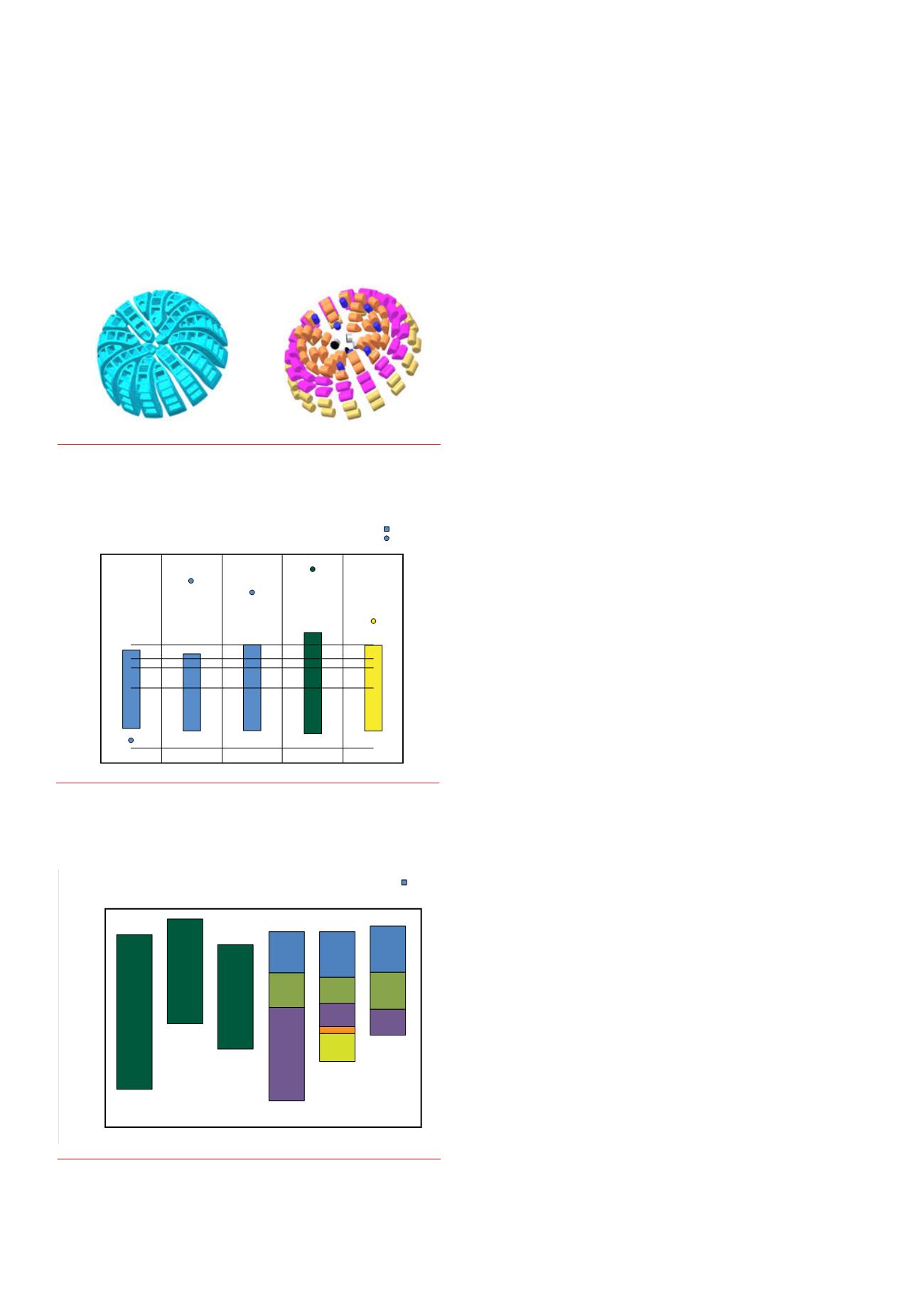
32 |
Oilfield Technology
June
2016
For example, experience in Canada determined that
increasing the blade height increased durability. Not only did
this increase the diamond volume of the blade, but it also
allowed more geometric space ‘inside’ the blade to work with.
HIP inserts were made bigger, which was advantageous as they
have superior diamond dispersion characteristics.
A second development for the bits used in Canada were
the design changes to reduce the likelihood of the bit getting
stuck. The overall length of the bit was reduced to decrease
the bit-to-bend length, the passive portion of the gauge was
undercut, and back ream cutters were added. The enhanced
performance was not achieved on the first bit run, but instead
was the result of ongoing design modifications all based on the
concept of custom designing the bit for a specific formation.
Canadianrunperformance
Fusion bits have been used in many Canadian wells with a
significant improvement in performance versus competitor bits
used in offset wells.
In the Lily Field in British Columbia, Canada, the Fusion bit
drilled faster and for a longer time than any other bit used on
the well pad, requiring only one bit to drill the section. Drilling
the 8 ½ in. vertical and build section typically requires two DI
bits to drill the full interval at an average of 2.5 m/hr (8.2 ft/hr).
By drilling 204 m (669 ft) at 3 m/h (9.8 ft/h), the Fusion DI bit
improved the average ROP by 20% and eliminated the cost of
another trip and a second bit.
The record setting performance is mirrored in other Canadian
applications that have also seen improved durability and ROP
using the application specific bit design.
In the Graham Field, the first run of a Varel VF1213 171 mm
(6 ¾) DI bit drilled above average footage at the fastest ROP
compared to offset DI runs drilled by two different competitor
bits in four separate runs. The Varel design made 84 m in
29.75 hours at 2.82 m/h compared to the offset average of
78.25 m drilled in 39.46 hours at 2.03 m/h. The Varel F1213 drilled
29% faster than the competitor average.
The Graham Field illustrates the type of formations where
the DI bits are used. Typically tripped in at the bottom end of
the Charlie lake formation and pulled just before the Montney,
the bits encounter an unconfined compressive strength (UCCS)
of 30 to 45 kPSI through this section. The lithology is primarily
abrasive sand, limestone and silt, making this an ideal candidate
for DI bits as PDCs dull off rapidly and roller cone bits are very
slow (< 1m/hr).
In the Town Field, a 216 mm F1616G2U Fusion bit drilled
194 m in 55.25 hours at 3.51 m/h compared to the offset
average of three offset bits of 153.6 m in 46.25 hours at 3.33 m/h
(Figure 1).
An Altares Field application used a 171 mm F1213 Fusion
bit to drill 217 m in 77 hours at 2.82 m/hr, 93% further than
the average meterage (112 m) in the area. All runs utilised a
high-speed motor. The formation compressive strength in this
section can reach as high as 45 kPSI with extremely abrasive
sand making conventional drilling uneconomical. To give an
example of how challenging this section is to drill, a six blade
13 mm PDC bit was tested. It drilled 7 m at 3.11 m/hr before
being pulled for penetration rate. The Varel F1213 allowed
the customer to stay on bottom longer while achieving an
exceptional rate of penetration.
Omanrunperformance
In Oman’s West Khulud Field, an F1613G Fusion bit now holds the
top three records for an 8 ⅜ in. single-run diamond-impregnated
bit. The most recent run increased footage by 46% over the
second run and a 223% gain in average offset footage using other
bits (Figure 2).
The Fusion bit runs in one of the deepest gas fields in
the world were initiated to exit the casing shoe and drill as
deep as possible in a single run. The field’s lithology presents
a significant challenge with abrasive sand, shale, and silt
exhibiting unconfined compressive strengths in the range of
Figure 1.
Varel modifies HIP segment size, shape, andplacement to
ensure the best designpossible for any application.
Figure 2.
Varel’s 216mmF1616G2Udrilled 26%farther than the
average offset in Town Field, BritishColumbia.
Figure 3.
The F1613Gused in thisWest Khulud Field run saved the
operator two trips, two bit changes, and eight days fromthe planned
schedule.
Impreg
Impreg
Impreg
F1616G2U
Average
216 mm Impreg Runs - Town Field, British Columbia
1650
1700
1750
1800
Amrk
Artex
Halfway
Doig
Montney
1850
1900
1950
2000
2050
3.0
3.05
3.1
3.15
3.2
3.25
3.3
3.35
3.4
3.45
3.5
3.55
Drilled Interval
ROP
Measured Depth (m)
ROP (m/hr)
F1613G
F1613G
F1613G
Impregs
Impregs
Impregs
2.15 m/hr
1.97 m/hr
2.1 m/hr
2.07 m/hr
1.34 m/hr
1.42 m/hr
8-3/8” Impreg Runs - West Khulud Field, Oman
Drilled Interval
Well Depth (m)
4000
4200
4400
4600
4800
5000
5200


